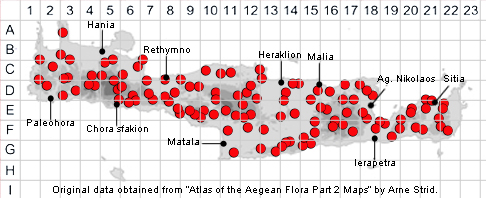SPECIES DESCRIPTION
CENTAUREA IDAEA
Family and Genus:- See- COMPOSITAE/Subgen. SOLSTITIARIA
Common Name:- None
Homotypic Synonyms:- Calcitrapa idaea.
Meaning:- Centaurea (Gr) Centaur, Centauros. The centaur Chiron was cured of a
hoof wound with this plant.
Idaea (L) From Mount Ida in Crete, or Mount Ida in NW. Turkey.
General description:- Biennial plant with numerous stems.
Stem:-
1) Central, very short, the others 10-15(-30) cm, more or less branched.
Leaves:-
1) Greyish-green beneath, an arachnoid indumentum above.
a) basal, 10-13 cm, in a rosette, oblong in outline, lyrate-pinnatifid with ovate-
triangular, dentate lobes, the apical 3 times as large as the others;
b) upper, linear.
Flowers:-
1) The first flower head is produced at the apex of the main stem which is very
short. The rest of the plant is made up of side branches.
2) Capitula, solitary. with yellow, grandular florets.
3) Involucre, c.10 mm diam,
4) Bracts, tomentose, yellowish.
5) Appendages, not decurrent, with apical spine 15-30 mm and 1-2 short black
lateral spines.
Fruit:-
1) Achenes, c. 2·5 mm.
2) Pappus, absent in outer florets, as long as the achene in the inner.
Key features:-
1) Stem, up to 15 cm.
2) Involucre, tomentose.
3) Apical spine of appendages 15-30 mm.
Habitat:- Stony and rocky hillsides, fallow fields and wasteground, generally at 800-
2000 m.
Distribution:- Endemic to Crete where it is widespread and common.
Flowering time:- June-July and sporadically at other times.
Photos by:- Steve Lenton
